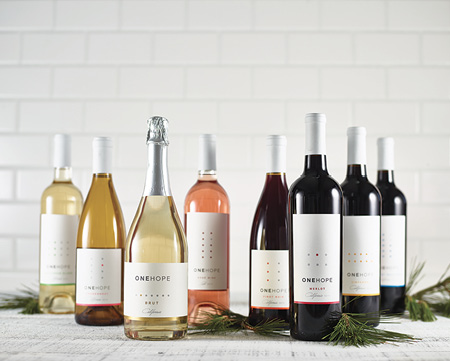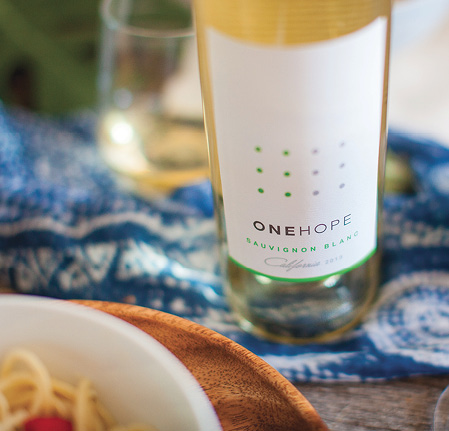- Home
- Media Kit
- Current Issue
- Past Issues
- Ad Specs-Submission
- Ad Print Settings
- Reprints (PDF)
- Photo Specifications (PDF)
- Contact Us

![]()
ONLINE

Growing a Vision
Editors’ Note
Jake Kloberdanz has been recognized by Businessweek as one of the “Top 25 under 25,” Wine Enthusiast’s “40 Under 40,” and was the youngest nominee for Entrepreneur of the Year by Ernst & Young. A graduate of UC Berkeley, he has served over 5,000 volunteer hours since 2001, and has been widely referred to as an expert in cause marketing and branding.
Company Brief
ONEHOPE’s (onehopewine.com) mission is bringing people together to celebrate and serve the world. Primarily produced in collaboration with Rob Mondavi Jr., ONEHOPE’s product portfolio includes award-winning wines with a measurable social impact. For example, every case of Sparkling connects 25 meals to a child fighting hunger in the U.S. The cause-centric business model empowers them to give back to multiple causes. They believe that giving back is good business, which is reflected in all aspects of the company: products, community, vineyard, foundation. To date, more than $2 million have been donated.

Each ONEHOPE Wine is paired with a charity,
allowing people to serve a cause they are
passionate about while they enjoy great wine.
How has your vision for this company evolved to where it is today?
One of the most exciting things for me is that we have moved from a relatively big vision to a much bigger vision, and it continues to grow.
It initially started around creating three simple wines directed at three causes. We wanted to provide a really high-quality product to people that they really like and will return to buy year-round. We wanted to be able to not only make an impact on a national level, but also put cause entrepreneurship behind raising money for the local community.
Over time, not only have we grown the product line to more than 40 different wines and more than 100 different products that we offer between the wines, coffee, and gifts, but we have also grown beyond products into experiences. The idea is to provide an experience around enjoying wine and indulging in other great beverages and gifts for a good cause and being able to do that not only at a restaurant or hotel, but also in the comfort of one’s home.
We’ve grown the vision to building a community of cause entrepreneurs with viaONEHOPE. These inspiring people are raising money for their local causes, providing a fundraising vehicle in the community, and also democratizing the Napa Valley wine experience. It gives people who might otherwise not be able to visit Napa and drink the kind of wines that ONEHOPE has in its portfolio the ability to enjoy that and also learn about the causes they’re supporting, as well as the causes we’re already affiliated with. The experience part of the vision has become a bigger focus even as we’ve continued to grow our product offerings.
We also recently bought a vineyard in the Rutherford region of Napa Valley and are starting to build a flagship property where people can experience our brands at an even more intimate level.
We’ve expanded from being a consumer brand and product line to building a huge community of more than 1,000 cause entrepreneurs who are helping tell the story and being part of our platform.
The vision is ultimately to provide a cause-centric platform for people to do good, be it through their daily consumption or through their daily efforts to build their own cause-centric business.

In some ways, has the business outgrown the name, even if wine still is at the core?
We now refer to ourselves as ONEHOPE not ONEHOPE Wine. As a brand, we really are ONEHOPE and we have grown beyond wine. We’re not just a wine company – we’re also a community of cause-entrepreneurs; a go-to gifting company; a world-class vineyard; and, increasingly, a technology platform.
Are there additional opportunities that would present natural extensions for the brand?
We feel confident in our ability to source and deliver really great high-end beverages, so coffee and wine fit in there, as well as other things that go along with that experience. We look at anything from cheese boards to glasses to candles because they might fit from a pairing standpoint when it comes to enhancing taste or other senses like smell and sight. As we start to look at other core products for ONEHOPE outside of those pairings, we still stay pretty focused on the beverage area and things that go along with that experience.
You developed this company around cause branding. Is that phrase being overused today?
Cause marketing is defined as a temporary marketing campaign between a for-profit company and a nonprofit to raise money for the nonprofit and spike sales for the for-profit. This has been an effective way of marketing and has raised a lot of money.
Over the past decade, a transition has begun with cause-centric commerce where it’s being built into the fabric of companies on a daily basis.
When we think about what the future looks like for businesses, there are more entering the cause space and the concept is becoming less unique. Is it losing its meaning? Not really; it’s really just losing its uniqueness, which is the whole goal of the movement. This should become normal and the status quo for businesses. As a company, we have already taken a look at what success looks like and have defined it as creating a movement that makes our brand stand out less. That seems counterintuitive because there is a great deal of discussion around the fact that if most nonprofits actually accomplish what they set out to do, they are no longer needed.
The reason we are very sustainable is that we have endless numbers of causes. There will always be a variety of measurable impacts we can have, even if one of the causes or challenges we’re trying to impact is ultimately solved.
As a greater number of businesses enter this space, a greater number of social issues are going to be solved via direct relationships between for-profit businesses and nonprofits that are helping to solve issues. That direct relationship is what we’re looking to grow over time, while also helping businesses grow over time.
We don’t think the phrase is losing its meaning. We think that every day, we’re losing our edge in standing out for doing this and that is a sign of success, and of the market going in the right direction.
We’re looking ahead and figuring out how to enable that movement and how to be a little part of what many other businesses need to do to be able to participate in addressing these causes.•